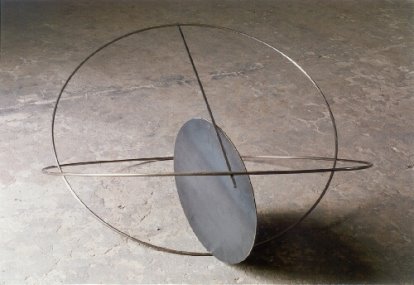|


Gleichgewicht, Balance und die Unruhe darin II/I 1989/88
|
The sculptures seek to create a visual image of the processes they trigger, the interaction and the
shifting that results, for example, when loads are distributed. By virtue of their inherent forms of
motion, the works intend to unveil and visualize the energy exchange that takes place, an ex-
change that is all the more tense and simultaneously delicate because of the highly precarious
point at which balance is achieved. In reference to his “Slack Water” cycle, Jan Meyer-Rogge
once noted that “quieted motion is the point of equilibrium.” That idea carries over into other
cycles of his, whereby—as mentioned earlier—within the field of tension that surrounds balance
there is also always a moment of restlessness. This theme is explicitly developed in the cycle
“Equilibrium, balance, and the restlessness therein.” Here a 
sense of restlessness arises from the different forms of the
composing elements, e.g., a ring and a flat bar, or a ring
and a circular disk, as well as from the number of elements
used. Two elements are the absolute minimum and achieve
an expression of balance at its only possible point, whereas
three elements produce the intended feeling of uneasiness
in the stable and yet highly fragile plastic constructions even
when they are positioned in a state of equilibriumand balance.
|